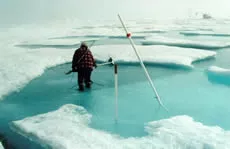Cryosphere glossary
the cryostructure of frozen sand and gravel in which all mineral particles are bonded together with ice, but larger pore spaces are not completely filled with ice.
the largest sea ice extent during a given year; maximum ice extent marks the end of the growth period for sea ice, and the start of the melt season
the properties of frozen ground governing its deformability and strength.
a ridge-shaped moraine in the middle of a glacier originating from a rock outcrop, nunatak, or the converging lateral moraines of two or more ice streams.
unlike snow dunes that are piles of drifted snow, antarctic megadunes are long, undulating waves in the surface of the ice sheet that are 2 to 4 meters (6.5 to 13 feet) high and 2 to 5 kilometers (1 to 3 miles) apart; they are slightly rounded at their crests and are so subtle that a person on the ground cannot see the pattern.
pools of melted snow and ice on the sea ice surface created during the summer melt.
Image

Scientist taking measurements in a melt pond.
Don Perovich, U.S. Army Cold Regions Research and Engineering Laboratory
a channel within, underneath, on top of, or near the side of a glacier that drains meltwater out of the glacier; usually kept open by the frictional heating of flowing water that melts the ice walls of the conduit.
a mercury-filled glass tube in which the height of the mercury column is a measure of air pressure.
an atmospheric circulation in a vertical plane oriented along a meridian; it consists of the vertical and the meridional (north or south) components of motion only.
the region of the atmosphere between about 50 kilometers (31 miles) and 80-85 kilometers (50-53 miles), extending from the top of the stratosphere to the upper temperature minimum; it is characterized by a broad temperature maximum (near 0 degrees Celsius) at its base, from which the temperature decreases to a minimum (about -90 degrees Celsius) at the mesopause level.
changes in the structure and texture of snow grains which result from variations in temperature, migration of liquid water and water vapor, and pressure within the snow cover.
any one of the properties or conditions of the atmosphere which together specify the weather at a given place for any particular time (for example, air temperature, pressure, wind, humidity, thunderstorm and fog).
study of the atmosphere and its phenomena, including its structure, properties, and physical processes.
closed, multi-sided, roughly equidimensional, patterned ground features, less than 2 meters (6.6 feet) in diameter; usually caused by desiccation cracking of fine-grained soil materials.
in terms of wavelength, microwaves range from 1 millimeter to 1 meter, and are much longer than the shorter visible (0.38-0.78 micrometer) wavelengths; these longer wavelengths allow microwave energy to penetrate through clouds; because these sensors measure microwave energy, they do not rely on sunlight for illumination so they can acquire images regardless of time of day; can be either passive or active; passive sensors detect and record naturally upwelling microwave energy emitted from objects; active sensors generate their own beam of energy, generally with an antenna, which then detects the returned energy patterns (backscatter) that indicate the presence of features and their position relative to the sensor; radar (radio detection and ranging) was an original active microwave sensor that became widely operational with the onset of World War II.
clouds composed of ice crystals and water droplets in the middle region of the atmosphere, from 2,000 - 6,000 meters (6,500 to 23,000 feet); includes altocumulus, altostratus, nimbostratus, and portions of cumulus and cumulonimbus clouds.